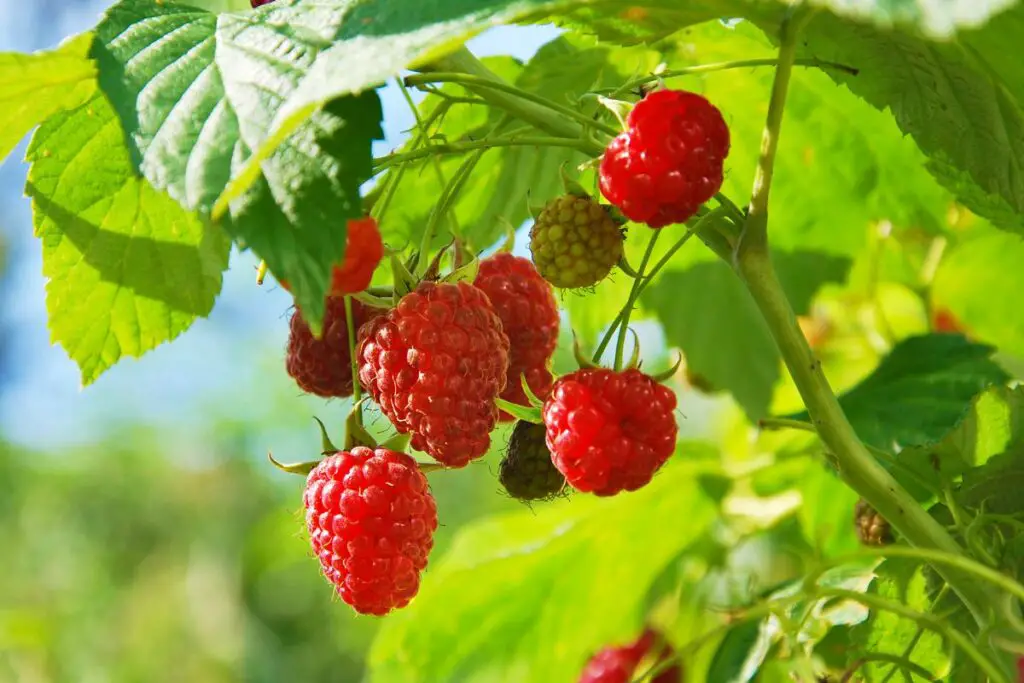
Raspberries, with their tantalizing burst of color and flavor, are a gardener’s dream. But when exactly do these little jewels grace our gardens or the farmer’s market?
Raspberries predominantly grow in the summer and early fall, although specific times vary depending on the type of raspberry and regional climate conditions. Some varieties can produce a smaller, earlier crop in late spring to early summer, followed by their main harvest in late summer to early fall.
In the following sections, we’ll navigate the nuances of raspberry varieties, their distinct growing seasons, and the elements influencing their growth. To provide a comprehensive view, we’ve also incorporated insights from seasoned horticulturists.
The Raspberries’ Calendar: When Do They Really Ripen?
Distinguishing when raspberries ripen hinges largely on their type and the ambient weather conditions. There are two primary categories:
- Summer-bearing raspberries: Predominantly, they yield one substantial crop, generally around June or July, lasting a few weeks. Renowned varieties include ‘Heritage’ and ‘Latham’.
- Ever-bearing (or fall-bearing) raspberries: These can surprise you with two yields. The first, a modest one in late spring to early summer, and the subsequent, more generous bounty from late summer to early fall. Varieties like ‘Fall Gold’ and ‘Autumn Bliss’ belong here.
According to Sarah Bennett, a horticulturist with over 20 years of experience, “The distinction between raspberry types is crucial for garden planning. Understanding the growth pattern ensures a steady stream of fruit, maximizing the garden’s potential.”
Factors of Raspberry Growth
Certain conditions and factors can subtly or overtly influence raspberry growth and maturation:
and maturation:
- Climate and Zone: Raspberries are versatile, growing in USDA Hardiness Zones 3 through 9. Yet, the best-suited variety might vary. Colder regions lean towards summer-bearing raspberries, while milder zones can accommodate both.
- Sunlight: Bennett emphasizes the vitality of sunlight for raspberries. They need a minimum of 6-8 hours of direct sunlight daily. A deficit can prolong fruiting and reduce yield.
- Soil: Raspberries prefer soil that drains well, fortified with organic constituents. Neutral to slightly acidic pH levels (5.6 – 7) are most conducive.
Strategies for a Fruitful Raspberry Season
A hands-on approach to raspberry care can ensure they fruit right on schedule:
- Pruning: Consistent pruning enhances fruit production. Summer raspberries require post-harvest pruning, whereas ever-bearing ones need attention post the spring yield and again in late winter.
- Watering: Though resilient to drought, raspberries thrive with steady watering. But, as Bennett warns, overwatering or stagnant water exposure can induce root rot.
- Fertilizing: A balanced fertilizer can bolster raspberry growth. Adhering to the guidelines specific to the raspberry variety is pivotal.
As Bennett often shares in her workshops, “Raspberry care isn’t just about the right steps but the timing of those steps. A keen understanding of their growth pattern, married to timely care, ensures a bountiful, timely harvest.”
Raspberry Cultivation – Tips for Beginners
For those inspired to cultivate their raspberries, here are some beginner tips:
- Choosing the Right Variety: Based on your region and intended harvest time, select the right raspberry variety.
- Planting: Early spring is ideal. Ensure a spot with good sunlight and well-draining soil.
- Spacing: Give plants about 2 feet of space to ensure ample growth.
- Support: Using trellises or stakes can help support growing canes and yield better fruit.
Historical Context of Raspberry Cultivation
The cultivation and appreciation of raspberries can be traced back thousands of years. Originally found growing wild in Eastern Asia and North America, raspberries were valued not only for their sweet flavor but also for their medicinal properties.
Ancient Cultures and Raspberries: Many ancient cultures, including the Greeks and Romans, cultivated raspberries. They were often used in medicinal concoctions, believed to help alleviate stomach problems and labor pains.
Migration and Cultivation: As trade routes expanded, so did the raspberry’s popularity and cultivation. By the Medieval era, monasteries in Europe became centers for raspberry cultivation. They recognized the importance of both the fruit and its leaves, which were made into herbal teas.
Nutritional Benefits of Raspberries
Raspberries are not just delicious; they are a powerhouse of nutrition.
- Vitamin C: A single serving provides over half of the daily recommended intake, vital for immune function and skin health.
- Dietary Fiber: Raspberries are an excellent source, which aids digestion and helps maintain a healthy weight.
- Antioxidants: They contain powerful antioxidants like quercetin and ellagic acid, known to combat oxidative stress.
- Minerals: Rich in manganese, vitamin K, and magnesium, they support bone health, blood clotting, and enzyme function.
Conclusion
The summer and early fall season serenade us with the delightful taste of raspberries. Yet, the exact growth period is a tapestry woven with variety specifics and regional quirks. Comprehensive knowledge of raspberry growth stages, enriched with expert insights, equips enthusiasts to anticipate ripening accurately and refine care strategies
